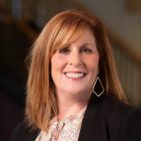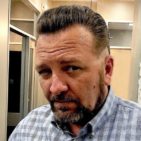Life is starting to look a bit more normal than it has in a long time for talent management in healthcare organizations.
To say operating during the pandemic was challenging may be the understatement of the century. The dire circumstances faced by the healthcare industry exacerbated the already existing HR and talent issues within organizations including worker shortages, a high stress environment, and burnout. In this kind of an environment, it is completely understandable why talent development teams might lose focus on moving the needle toward talent management goals and strategies when many organizations were just trying to stay afloat. However, some organizations have found a way and we wanted to dig in and explore their stories further.
For this post, we interviewed Jennifer Watson, System Director for Organizational Development, and Tony Fullen, Corporate IT Manager, at Baptist Health System about how they’ve been able to collaborate cross-functionally and drive progress for their organizational talent management and development function even during such a tumultuous time. Baptist Health is a not-for-profit system of nine hospitals with over 400 points of care throughout Kentucky, Southern Indiana, and Illinois. While traditionally operated as independent hospitals, the organization has been going through a transformation to systemize and begin operating as a single entity.
Below is a synopsis of the interview which has been edited for clarity.
YOUNG: Can you tell us a little about Baptist Health and your role specifically?
JENNIFER: I am the System Director for Organizational Development and primarily, my role is to oversee the Talent Development team, which is a very small team of four talent development professionals. Our purpose is to identify the learning needs of the broader organization and then find ways to fill those gaps with tools and resources. In addition, I sit on several cross-functional internal councils that we’ve established which create an opportunity to have conversations about the best ways to come together cross-functionally as a system. For example, we have an HR Council, Develop You Council (the group dedicated to ensuring our stakeholders know how to use our learning system), and a Learning and Education Shared Governance Council which is a combination group that sits on top of the other two councils. Our purpose is to bring together the entire organization in a way that makes sense and results in more cohesive learning strategy for the system.
TONY: I am the Corporate IT Manager for the Web Development team and I’ve been with Baptist for almost 8 years now. I began managing the Learning Management System technical team five or six years ago because of my background developing training for the military. When I started here, we had a homegrown LMS that served only five of our seven hospitals. Our directive was to get off that old platform because it wasn’t supporting the current needs of the organization and it didn’t have the ability to scale. Not to mention, this meant we had potential technical points of failure and maintenance service levels insufficient for our needs. So, we decided to implement a new learning system and selected Cornerstone SBX (formerly known as Saba Cloud) as our platform as it is one of the leading healthcare talent management software vendors. Looking back, it was one of our best decisions because it has facilitated a lot of growth both in the organization and within learning and education in general.
YOUNG: When it comes to learning and development, and more generally talent management in healthcare, the clinical stakeholder is traditionally the strongest, loudest voice. What has the L&D environment been like traditionally at Baptist Health?
TONY: Like some healthcare organizations, we do not have a Chief Learning Officer. Instead, we’ve relied on employee surveys to help us understand what the needs and pain points are from a learning and development standpoint. Out of those surveys came the idea of that Jennifer sits on. The Council was established to discuss and prioritize any business needs and directives, communicates them out to our other governance councils, and then we work together to figure out the best way to accomplish the objectives in Cornerstone SBX.
JENNIFER: This is a big deal for us, this that’s come together. There is a lot of opportunity for development focused on the competencies that we deal with at an organizational level as opposed to the very clinical nature of the business that we’re in. With most of the education traditionally being led from a clinical standpoint, we’ve been lacking an overarching organizational development strategy and that’s what my team has been brought in to do. But it takes time, you don’t just flip a switch. We’ve really come a long way in the few short years that my team has been in place, but it is a struggle. We’re not trying to own the clinical side of it. We’re looking at it more from the business side of things, trying to help people understand the opportunity, and then bring both sides together. It’s one of our biggest challenges right now.
YOUNG: It sounds like this transformation to your learning approach stemmed from having a centralized, foundational talent management system like Cornerstone SBX in place, but the partnership between the people on the business and technical side is how you have really made all the gains. You’ve found a way to bring together HR, Clinical, and Technology collectively with these Governance Councils.
JENNIFER: Well, they existed before but they were operating in silos. For example, the Develop You team was established to bring everyone together when we launched Cornerstone SBX. We have members from all other Councils that sit on the Develop You Governance Council. The challenge with just that one Council was that SBX is a tool for us, and its charter was very technical in nature. We also needed to have an overarching philosophical approach for learning and education that could then be supported by our tool.
Talent Development is such a small part of the HR world and for many years, there was no voice whatsoever at the table for it. It was an afterthought. We are now in a world where retaining talent is critical to the business and they are beginning to understand that some of the things we’re doing in organizational development is a great way to make our retention goals a reality. But it’s still hard to turn a huge ship.
YOUNG: In healthcare talent management, changes can be very incremental if they happen at all. You have the three buckets – HR, Clinical, and Technology – and it’s difficult to get them aligned. We see a lot of organizations that might have a strong HR function and a lot of great ideas, but the tool or the people supporting it, just can’t seem to keep up. Or the tool is ready to go but there’s not enough vision and direction from the business side. The way Baptist Health has brought strength in all three areas and opened the doors to each other is great. And I love that your IT system is called Develop You. It puts development right at the forefront.
TONY: That’s a good point. Development was always the primary goal with launching a new system from the very beginning. You know the last two and a half, three years it has been difficult for any of our clinical folks to be able to develop anything. They barely have time to breathe. So, the fact that we have been able to continue moving forward on a lot of our initiatives regardless of that says a lot.
JENNIFER: I think so too, Tony. Although when we talk about Develop You, I still get frustrated with the fact that things are called “Develop You modules” but so many times they are compliance-driven training. We have more work to do to move away from the compliance mindset and become a place where people can go to grow and learn. The whole mindset of compliance is still a little too prevalent for my liking.
YOUNG: Both are great points. How do you think you’ve been able to still make progress given the external and internal challenges?
TONY: Well firstly, thank goodness for the nurses and the doctors that have been carrying the burden of this pandemic and have done it so well. I know it’s not been easy at all but because they have handled that, it’s given us the ability to keep focused on the bigger picture and to drive things forward. Another thing, working remotely from home has made a huge difference in my team being able to focus and have minimal distractions during the day. I’m a big picture person and I think Jennifer is very much the same way. That quiet space gives me time to think.
JENNIFER: The other thing I would add is necessity. My team was formed in December of 2019 and while the business knew there was a need, we were just beginning to build out our strategic vision at the onset of the pandemic. So, we had to put it on pause. We had to move everything to remote, reprioritize and focus on switching everything from in-person to webinar-based and computer-based learning. The necessity moved us forward more quickly than we would have been able to do before. We had to be agile, and we had no choice but to cut the red tape. We knew what we needed to do, and people gave us the space to do it. Another thing – we had the freedom to fail. Nobody expected it to be perfect. We made a lot of progress and we learned how to do it together with the rest of the world.
YOUNG: It’s great that you were able to find ways to focus and keep making progress. Now that we are beyond what seems like the worst of the pandemic, what would you say are some of the priorities and key objectives that you have going forward?
JENNIFER: Well, it’s back to my vision which is centered around providing development and career pathing for all our employees. Individualized and personalized opportunities for people to grow and to see their path forward, to understand how to make that happen, to understand what skills are required, and then to build those skills. The foundation in my mind is a skills-based foundation. If we build it out in Cornerstone SBX, we really have an opportunity to identify what skills people have and then tie those back to learning.
Then there are the other pieces – identify which open positions have which skills so that we can build those career plans out, identify succession plans based on what skills people have, and tap performance back into it so that we understand who our high potentials are and develop those people for the future roles that we know exist or will exist. It sounds simple, and yet it’s so complex.
TONY: What Jennifer just outlined clearly defines where she wants things to go and so now it’s just a matter of figuring out how we get there. My team’s goals are to align with the business and what her team needs. Obviously, we have regular support and maintenance and other requests that come in, but I’m on board with her vision, figuring it all out from a systems perspective, and moving forward just like we have with other things.
YOUNG: When I think about all the pieces of your vision, the phrase, ‘perfect is the enemy of progress’ keeps coming up in my head. And I know this vision is bigger than what we were talking about earlier with how you made progress during the pandemic, but in some ways, achieving this vision takes the same mentality. You take a few steps forward, if it doesn’t work out, you still have made some progress. I think the unique thing here with Baptist is the fact that the two of you have been partnering together over the last few years, and you have some critical pieces already in place that are typically obstacles. That puts you in a great position to continue to expand on the vision.
To wrap things up, what advice would you give to other healthcare organizations that may be struggling to do some of the same things you’ve been able to accomplish at Baptist Health?
JENNIFER: I think the word that comes to my mind is intentionality. Be very, very intentional about what you are doing and how it is tying back to the greater strategy and priorities of the organization. It’s one of the things that I think we have done very well. We’re very tuned in to what is happening in the world, and always asking, ‘what do our people need’? How do we support them while keeping in mind the bigger strategy as we’re moving in that direction? How do we prioritize and focus on our strategic organizational priorities and match those up with what’s happening in the world and what’s happening within our employee population?
TONY: Being observant as well as intentional. One of the great things about Baptist Health in my mind is that they truly do, at all levels, care about their people and they prove it time and time again. They are always looking to find new ways to encourage people, to empower them, and give them the tools that they need to manage their work-life balance, even during life in a pandemic. Care for your people – that would be my number one suggestion. Because at the end of the day, that’s who it is all about.







